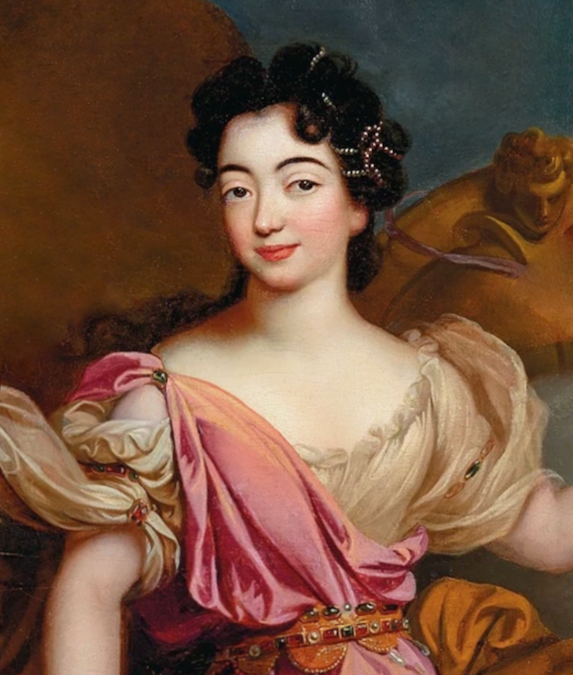~ The two fell deeply and passionate in love and desired to marry but their families opposed, and locked Charles in the chateau. That didn’t stop the lovers! Charlotte-Rose dressed herself in bear suit, and disguised as a dancing bear she entered the chateau with a group of theatre actors; she then entered Charles’ room, still in her bearsuit, the two lovers reunited and escaped together, marrying in a church in Paris a few days later. ~
Around hundred years before Brothers Grimm published the fairy tale Rapunzel as part of Children’s and Household Tales, was the French literary tale of Rapunzel called Persinette written by French author Charlotte-Rose de Caumont de La Force, which itself was an alternative version of the Italian original literary tale called Petrosinella by Giambattista Basile in 1634. As we unfold the layers of tales, stories within stories, made and lived by us as humanity, a world opens to us – and we find the real stories: stories of trust, stories of faith, stories of courage, stories of love.
Today I’ll share with you the real life story of the French author Charlotte-Rose de Caumont de La Force, and how while her version of Rapunzel was a gentle retelling by the Italian tale, it was her real life that inspired and perhaps even made her live out the secrets threads of wisdom she then wove into her tale. Dear story lovers, let’s begin!
The term “fairy tale”, which nowadays is a generic label for magical children tales, was actually started by the literary salons of 17th century Paris by a group of writers who wrote and published tales for adult readers. As such, these tales often included themes that were a bit darker, uncomfortable, or taboo to reflect the human condition and moral and socio-economical issues of their society and current times. In a meaningful way, these writers were essentially raising awareness and giving voice to themes often not talked about or restricted to talk about; and through the gentle magical disguise of a “tale” or even comedy, they reflected the truths of people, societies and the voices of those not being to speak nor be heard.
The Italian tales by writers such as Giambattista Basile and Giovan Francesco Straparola, who wrote the original stories of Rapunzel, Cinderella, Sleeping Beauty and Snow White, were the inspiration for generations of writers in Paris. The French salons were gatherings hosted by prominent aristocratic women, where they discussed important issues of the day such as social issues of marriage, financial and physical independence, love, health and access to education. These were times of oppression and suppression, where divorce was unheard of, abuse was a daily reality, childbirth death was common, education was not given to most women and arranged marriages were the norm. Some of the most gifted women writers came to these salons, one of which was Charlotte-Rose de La Force.
She borrowed elements from the original Rapunzel called Petrosinella by Italian writer Giambattista Basile sixty years prior, and wrote her retold version, called Persinette, publishing it in her fairytale collection Les contes des contes in 1697. La Force was part of the group of writers who created adult fairytales in the literary salons of Paris, including the other writers, Charles Perrault, Madame D’Aulnoy and Madame de Murat.
Many people might see Rapunzel as some tale about a weak girl who plays a victim locked in a tower, waiting to be saved – and as such disempowering. But if one actually seeks deeper into the tale, and understands it, one would find that’s far from the truth. The tale of Rapunzel, told by both Basile and La Force, is actually very empowering telling the story of a young girl who was not weak at all. It is important to understand the essence of tales – and remember the history – so that we are more aware of just how important these voices were.
La Force was known as a very rebellious woman, who just like Basile wrote for an educated, aristocratic audience, and her tales were meant to both entertain and bring awareness to contemporary life. One of the issues of that period was the common practice of arranged marriages, where daughters were used to cement alliances and settle debts; they were basically sold off. Sex was the husband’s legal right, whether or not the woman wanted it, and consent was unfortunately a mirage. The disobedient daughters and women, who either refused to marry or raised their voice against abuse were often then sent away in convents or locked up in madhouses. As such, many of the French tales during those times were filled with stories about girls handed off to wicked witches or evil creatures, by their cruel parents, or locked up in towers where only true love could save them.
La Force and many other writers fought hard to champion the idea of consensual marriages ruled by love and respect. The emphasis on the themes of love and romance may seem silly to us today, but these stories were progressive, rebellious, meaningful and greatly important for their times. La Force herself was an independent thinker who came from a noble family and caused several scandals because she chose to live a life that was authentic and true to her heart.
Charlotte Rose de Caumont de la Force was born into an aristocratic family in 1650 that included writers and generals. Her father was François de Caumont de La Force, Marquis de Castelmoron and eighth son of Marshal de La Force, and her mother was Marguerite de Viçose, who was King Louis XIV’s second cousin, and also a relative of the conteuse, i.e. storyteller, Henriette Julie de Murat, who was a famous French aristocratic writer and leader of teh fairy tale movement, who published fairy tales and slightly scandalous faux memoirs, one of which got her exiled to the provincial town of Loches for several years.
At the age of 16, Charlotte-Rose was summoned to court to became a lady-in-waiting to the queen. The free spirited girl often scandalized the court with her un-lady behaviour and love affairs; first taking as her lover Moliere’s protégé, the actor Michel Baron, and then becoming engaged to the Marquis of Nesle, and even being questioned about doing magic spells on her lovers, because why else would they be obsessed with her. Luckily for her, she wasn’t found guilty and didn’t burn at the stake like many other women did during these times.
In her 30s, Charlotte-Rose fell in love with an impoverished actor called Charles Briou, who was much younger than her. They had a long passionate affair and desired to marry, but because of his lower social class their marriage was forbidden by both hers and his family. The king himself had given them permission, but Charles’ father was a general and both families still opposed this union strongly; so to prevent the marriage, Charles’ family actually locked him up in their chateau. That didn’t stop the passionate lovers!
Our darling Charlotte-Rose disguised herself in a bearskin, and entered the chateau with a travelling troupe of theatre actors as a dancing bear. She then entered Charles’ room, still in her bearskin suit, and the lovers reunited and escaped together!
They married in a beautiful church in Paris, finally happy and together. However, after ten days of happiness, their families eventually caught up with them and forced them to annul the marriage. After a lengthy trial, and Charles’ father influence as he was a general, the marriage was annulled and Charles was himself locked away in a madhouse by his parents. As for our Charlotte-Rose, aside from being heartbroken, she was also charged to pay a thousand gold louis.
To pay off the debt, she turned to writing, mainly short novels. Her works were quite satirical, often criticizing King Louis XIV and many important figures within the court, and displeased by her words and behaviours, the court gave her the choice of either exile or being locked in a convent. She chose the convent, and remained imprisoned there within the tall stone walls from around the age of 47 to 63. It was during her time there that she wrote her book of fairy tales that included Persinette, as well as writing a number of other “secret histories”. Eventually released, she spent the rest of her life earning her own living through her writing.
Strong willed and intelligent, and a free spirit and courage of soul, I believe her greatest love affair was with life itself, and living her life in the way that felt true and authentic to her, despite what others tried to impose on her. She was determined to remain a loyal lover to her own destiny making.
When I read Rapunzel I can’t help but think of Charlotte-Rose’s story – and it’s like this tale was a love letter, from her tower to Charles’ tower. In the tale, despite being separated, Rapunzel and her prince find each other again at the end of the tale. Perhaps the loving ending she may have desired for their love story, or at the very least, a peace, a love sealed in time, whether lived or unlived.
Rapunzel is not a passive character. When the time comes and she is faced with someone or something she truly wants, she is initiative and brave, as she is the one who plans the escape. And she never denied her true heart of love and kindness, despite Gothel’s jealous, possessive, controlling and evil ways.
I find Rapunzel may also teach us about the art of surrender. Fate doesn’t always come on our terms; it has its own timing. And often times, it requires acceptance and surrender. This doesn’t mean we don’t do anything with our lives – because we ourselves create our destiny by what depends on us, which is mainly our own hands, feet, mind and heart. There are times in life to lay low, other times we speak louder; we choose our battles and learn the cycles of the land. But in the meantime, even if stuck in a room, we develop our character which ultimately guides our choices, and this creates our destiny.
The love shared by Rapunzel and the prince also stand the test of time; it’s not superficial, as we actually see them move through the years, they separate and but again finally re-unite guided by the whispers of the heart. When they find each other again, he blind and she a mother of two kids in the desert, they still love each other. He loves her despite her short messy hair and castaway status, and she loves him too despite his inability to see. In a poetic way, it is her tears and the warmth of them and her love that bring his sight back. It kind of reminds me of the ending of Jane Eyre, how he too one day began to see the colours of her dress and jewels – a sight restored by love.
Rapunzel and her prince fell in love in a weird way, unexpected, unconventional, frowned upon and scandalous. They spent their love nights sneaking up in a secret tower. They had children together before marriage. He got dropped in a bush of thorns and lost in the forest, while she had to learn to navigate the wilderness alone and take care of herself and their children. They each suffered in their own ways, but eventually by the song of her sweet voice of love, he found her and they found each other again. And they continued to love each other. It’s a celebratory ending and possibly one of the most progressive and satisfying relationships of fairy tale narratives during those times.
What Rapunzel knows is love. She knows freedom of mind, spirit and heart. She knows that we are stronger than we think and we shouldn’t doubt how far we’ll go through thorns, mud and brick.
She knows that we carve our own destinies and that despite our circumstances we make a choice about the kind of person we want to be; that we can always look with eyes of love and hope and faith, and build a world beyond the walls. She knows that sometimes we are locked in towers but that doesn’t mean restriction because creativity is often born of limitation, and because love is borderless and always moves, always breathes.
And she knows that despite the walls or external cirumstances, one day, quite unexpectedly, something will speak in a voice of love or show its beautiful face, and we’ll let down our hair. No matter where, no matter how, like rivers flow to sea, what is will always be. Just be true to you. Stay true to you. Just like Rapunzel. Just like Charlotte-Rose La Force. Just like all those who chose to live an authentic life, and whose voices we can still read, sealed in time, on old pages of old books, stories of love, stories of trust, stories of courage still speak.
For personal readings with me, you are welcome to browse through my Offerings.

For more of my writings, browse through my Art of Love.
If you wish to support me and my work, you may do so by sharing it or donate here. For personal readings with me, you may visit my Offerings.
Your support means so much to me! Thank you wholeheartedly!
Cover art is a Portrait of Mademoiselle de la Force (1654-1724) as Flora in a landscape with cherub cupid circa, 1670-1690.




